Final Neolithic to Bronze Age Pottery from Mine N° 3
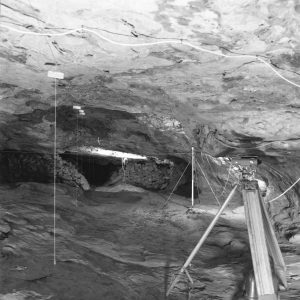
Mine Nr 3 during excavations
Dr. Margarita Nazou has been working on prehistoric ceramics from Thorikos since 2007. Her PhD project at the Institute of Archaeology, UCLondon was titled ‘Defining the regional characteristics of Final Neolithic and Early Bronze Age pottery in Attica’ and was funded by the Greek State Scholarships Foundation and the A.G. Leventis Foundation. An important aspect of the study was the presentation and classification of the Neolithic and Early Bronze Age pottery from Mine 3 at Thorikos. Mine 3 is Attica’s oldest mine and was excavated in the 1970s and 1980s by Herman Mussche, Paule Spitaels and the collaborators of the Belgian School at Athens. After successfully defending her Phd thesis in 2013, Dr. Nazou embarked on a post-doctoral project at Ghent University in 2014-2015, with Roald Docter as promoter; this research, funded through the Tricha Foundation of Education and European Culture and the Mediterranean Archaeological Trust, aimed at the final publication of the Neolithic and EBA material in the form of a monograph. From 2016-2019 a new post-doctoral project with Professor Jan Driessen as promoter received funding at UCLouvain through the MOVE-IN Louvain program (Marie Curie COFUND). The project, titled ‘Underground Mycenaeans: the archaeology of the prehistoric mining community of Thorikos (Attica, Greece)’ studied the EB III, MBA and LBA pottery from Mine 3 in comparison to other contemporary ceramic assemblages from Thorikos, such as the Stais collection from the National Archaeological Museum, and the prehistoric pottery recovered from the Belgian School at the Velatouri acropolis through excavation and survey.
MN
The Protogeometric, Geometric and Early Archaic Pottery

TC65.598, Ceramic pomegranate from Necropolis West
The comprehensive study of the Protogeometric, Geometric and Subgeometric pottery from Thorikos is a continuation of a doctoral dissertation from the 1990s. As the ceramic series at Thorikos are very fragmented, they are presented as part of an overview of contemporary Attic pottery.
Although the beginning of Protogeometric is traditionally dated around 1050/1025 BC, the earliest Protogeometric finds at Thorikos date only from about 900 (the beginning of Early Geometric). Protogeometric material was found with Early Geometric and early Middle Geometric material (up to shortly after 850 BC) in habitation layers near the Acropolis and below the West Necropolis, where a slightly later Middle Geometric I grave was also dug through the early layer.
Late Geometric and Subgeometric material was found mainly in the fill of two houses near the Acropolis and above early layers there, and in graves of Necropolis D1, Necropolis West and Necropolis South. A fine Late Geometric skyphos was found in a pit near a seventh-century house close to the Acropolis. The beginning of Late Geometric is dated around 760 BC, but graves of this period in Thorikos date only from shortly before 735 BC and later, with Subgeometric material found in the same locations. ‘Subgeometric’ means here pottery made after the Geometric period (c. 700 BC), but in a style that is a continuation of Geometric. Subgeometric pottery is thus contemporary with Early Protoattic ceramics, which are, however, very rare at Thorikos, unlike Protocorinthian imports and imitations.
Koen VAN GELDER
K. Van Gelder, The Early Iron Age at Thorikos, in: P. Iossif (ed.), “All that glitters…” The Belgian Contribution to Greek Numismatics, Athens, 41-43; R.F. Docter, P. Monsieur, M. Nazou, W. van de Put, K. Van Gelder, Thorikos. A Picture in Pottery, in: P. Iossif (ed.), “All that glitters…” The Belgian Contribution to Greek Numismatics, Athens, 44-51.
The Transport Amphorae and Stamps
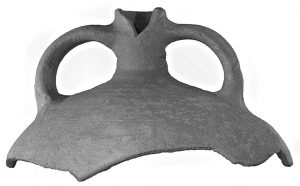
xGlobular amphora of probable Cretan origin, Tower Compound 1, 7th century AD? (TC73.187, Thorikos archive).
Amphoras functioned as standard transport vessels in antiquity, mostly for the wine trade. They are ubiquitous in all archaeological contexts in Thorikos.Their wide typology reveals origins in northern Greece, Corinth, Chios, Aeolia and several unidentified sites on the Asia Minor coast; some types from Corinth and Corfu may, moreover, have carried olive oil rather than wine. Archaeologically, amphoras occur in large quantities also because they were systematically re-used. In the context of mining activities specifically, one can surmise that they were re-used for water, and perhaps oil for lamps. Interestingly, in the Hellenistic period, the amphora spectrum of Thorikos was completely replaced by new types.
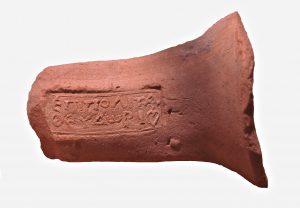
Hellenistic amphora stamp from Knidos with the names of the eponym Politas (civil servant) and the producer Theudoridas, and the producer’s symbol, a hedera (ivy leaf ),
found in a dump on top of the Theatre Necropolis
(TC88.131, Thorikos archive/KVG)
Knidos now dominated the market in Attica and the Cyclades, but Italic and Punic amphoras are also present, as well as specimens from Rhodos and Kos. Importantly, a remarkable amount of epigraphic evidence comes with transport amphoras, in the form of painted marks, graffiti and above all stamps. Patrick Monsieur is currently preparing the amphoras and fragments thereof stemming from the old Belgian excavations in Thorikos between 1963 and 1989 for publication in a comprehensive study to appear in the Thorikos series. The amphoras from the more recent excavations and survey are being studied by Andrea Perugini.
Patrick MONSIEUR and Andrea PERUGINI
The Black-Glazed Pottery
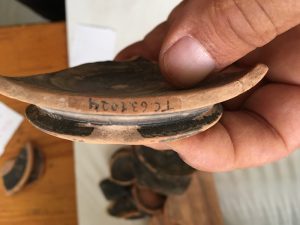
Black-Glazed pottery from Thorikos
Dr. Barbara Carè’s research focusses on the black-glazed pottery from Thorikos. The investigation aims at providing a typological, chronological and functional analysis of a ceramic assemblage including materials from a recent survey and excavations conducted by Ghent and Utrecht Universities (2012-2015). In the attempt to better understand the notions of “Athenian” and “provincial” pottery, a traditional approach combined with technical methods aims at detecting macro- and micro-features of the ceramic artefacts unearthed at Thorikos, promising insights into several aspects of ceramic technology and markets and distribution networks in Attica during the Historic period. Barbara Carè is an archaeologist specializing in Classical Archaeology. She received her Phd in Classical Archaeology at the University of Turin, Italy, focusing her research on material culture from the Greek site of Francavilla di Sicilia; she has held several post-doctoral positions in Greece as Fellow of the Alexander S. Onassis Foundation (18th Foreigners’ Fellowships Programme and 3rd Foreigners’ Fellowships Programme NSRF “Academy of Plato”) and at the Italian School of Archaeology at Athens. She has worked on ceramic assemblages from Greek sites in South Italy and Sicily and her research focusses now on ceramics from mainland Greece (including Attica and Thessaly).
BC
The people of Thorikos
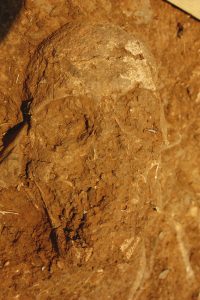
Human Skull
The excavations in the cemeteries of Thorikos since 1960 have demonstrated the occurrence of graves from the Mycenaean, Geometric, Archaic, Classical and Roman periods. The remains of approximately 100 inhumations and cremations from these periods link Thorikos to other sites in Attica. The region nevertheless is known for its ancient mines and metallurgic activities already from prehistoric times. In 1989/1990, human skeletal remains from Thorikos were the subject of a Master thesis at Ghent University by Luc Defever. Since then, they have remained unstudied and unpublished, except for a preliminary re-inventory by Francis Janot of the Université de Lorraine at Nancy. With the potential of new methodologies in the study of human skeletal remains, a whole series of new research questions come into reach: can we make a profile of the population of Thorikos? Are there differences in living standards with other known populations in Athens and Attika? Are there specific pathologies within the dataset of the site, particularly in relation with the heavily polluted industrial biotope? Osteological, biochemical and molecular analyses are expected to shed light on these questions. The prehistoric skeletal material is currently under study by Eleanna Prevedorou at the Malcolm H. Wiener Laboratory of Archaeological Science, ASCSA. The historical material will be studied by Anna Lagia of Freiburg University.
Eleanna PREVEDOROU and Anna LAGIA
L. Defever, De fysische anthropologie van het oude Griekenland, met inbegrip van een analyse van het skeletmateriaal uit Thorikos (Attika) (unpublished Master thesis Ghent University); F. Janot, Physical anthropological observations on a skeleton from the south-east Velatouri (Thorikos), Thorikos Reports and Studies 12 (forthcoming).
The monetary history of Thorikos, ‘rich in silver’

Thorikos coin hoard IGCH 134 (photo: PPI/V. Voutsas)
Thorikos and the Lavreotiki area as the main source for Athenian silver, at least from the period of the Archaic owls, are generally associated with the period of glory and wealth of Athens. Nevertheless, the monetary image we get from more than 60 years of intensive archaeological exploration of Thorikos (and the whole Lavreotiki broadly speaking) doesn’t corroborate the fabulous wealth extracted from the local mines. Only 18 coins have been found as stray finds during more than half century together with two hoards (IGCH 134 and the 4th c. AD bronze hoard).
The numismatic project under consideration intends to reconsider the numismatic evidence from previous campaigns, geo-localize the numismatic data in the GIS of the site and create coin circulation maps for Thorikos and the broader surrounding area. Emphasis will be given to the contextualization of the finds, especially the more recent ones, while the project will explore the working hypothesis of an “Athenian mint” at least partially operating in the area of extraction and process of metal. Therefore, the project will focus on the processing of metal ores at Thorikos (and the surrounding area) and the possible archaeological evidence which can be associated with the creation of flans and/or the striking of coins. The result, a work-in-progress, will be published as a series of articles and as an online database.
The history of the site deserves to be said through its numismatic evidence as well, even if the data available are quite scarce.
Panagiotis IOSSIF
The Ritual Landscape of Thorikos
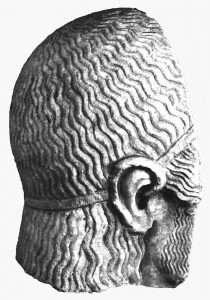
Marble head of Herm from the southwest corner of the cultic building in Insula 10, ht. 23.3 cm, 6th century BC (TP63.11, Thorikos archive/KVG).
Judging by the sacrificial calendar of Thorikos, it seems that cultic life in this ancient town must have been quite busy and vibrant. The cults reflect the population of Thorikos, their identity and their social interactions with other communities. The study of cults is therefore particularly interesting on the level of a local deme such as Thorikos. The history of Thorikos as a mining town is generally considered to have begun during the 4th century BC, under the increasing influence of Athens. This view on Thorikos, however, does not clarify how to define Thorikos in relation to Athens in the preceding period (900-300 BC). The ritual landscape of Thorikos can shed light on this issue, answering questions such as: How was cultic interaction used to relate to other local communities in southern Attica as well as to Athens? How did Athens influence the ritual landscape of Thorikos and how were local traditions kept alive? Excavations here have brought to light at least nine distinct cult sites, with cult activity from at least the 8th century BC up till the Classical period. Moreover, the sacrificial calendar of Thorikos provides us with an unusually complete picture of cultic local behavior. Besides the publication of some finds from cult contexts in preliminary reports, no comprehensive historical and functional analysis of these cults has been performed. The research project ‘The Ritual Landscape of Thorikos’ will aim to do so.
Silke DE SMET
References: Ekroth 2002, 150-53; SEG XXX, 147 cfr. Lupu 2005, 65; Labarbe 1977, 56; Mussche 1998, 59; De Smet, forthcoming; van den Eijnde 2010, 15 and 50.
Grinding- and crushing tools
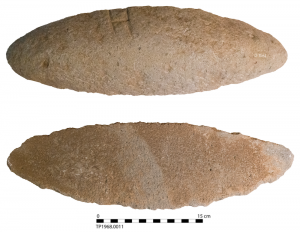
Classical handstone with graffito. Published in Bingen 1971, 162, Fig. 124
Grinding- and crushing tools in stone are of paramount importance in the history of humankind. Indeed, they allow the transformation of various raw materials, edible or not, in order to facilitate their preparation or use. To study these tools is to highlight the daily life of women and men in the past, as well as their domestic, artisanal and economic activities.
Since the 1960s, many grinding- and crushing implements have been discovered in Thorikos. From oval Bronze Age grinding stones to the fourth-century BCE hopper-rubber mills, they are of various shapes and are made of diverse and often imported rocks. With the exception of a chapter in a study by M. Waelkens (1990) on tool marks and mining techniques in mine n°3, they have not been systematically studied to date.
Sophie Duchène, a doctoral student at Ghent University (2017-2021), is now studying these objects as part of her doctorate. She is building a collection of them and studies their typology, as well as their provenance and function.
SD
WAELKENS M., 1990. Tool Marks and Mining Techniques in Mine n°3, in: Mussche, H., BINGEN, J., JONES, J.E., WAELKENS, M. Thorikos IX 1977/1982. Rapport préliminaire sur les 13e, 14e, 15e et 16e campagnes de fouilles. Voorlopig verslag over de 13e, 14e, 15e en 16e opgravingscampagnes. Gent: Comité des Fouilles Belges en Grèce/Comite voor Belgische Opgravingen in Griekenland, 115-143. Bingen J., 1971. Inscriptions, in : Mussche H., Bingen J., Servais J., Paepe R., Bussers H., Gasche H., (eds.), Thorikos 1968. Rapport préliminaire sur la cinquième campagne de fouilles. Voorlopig verslag over de vijfde opgravingscampagne, Gent : Comité des Fouilles Belges en Grèce/Comite voor Belgische Opgravingen in Griekenland, 149–162.
Demes of Attica
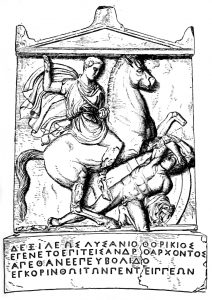
Athens, Kerameikos: stele and epitaph of Dexileos, son of Lysanias of Thorikos, who died as cavalryman in 394 BC (IG II(2) 6217).
How did rural communities cope with the devastations of war in the pre-modern world? The Peloponnesian War (431-404 BC), which pitched the maritime empire of Athens against the heavy infantry of the Spartan confederacy, is often compared to World War I due to the mass of combatant forces and the unprecedented scale of destruction. While the political context of the war has received considerable attention, in my PhD project, I seek to examine the resilience of the rural communities of Attica in the face of the social and economic impact of the war. Epigraphical evidence and archaeological remains indicate that the traditional view that the countryside of Attica was depleted as a direct consequence of the war, needs to be questioned. Applying a multidisciplinary approach, my research project will investigate the long-term resilience of the countryside communities (demes) by looking into the significance of the number of residents, of adaptations in their main modes of subsistence and of factors sustaining social coherence, notably religion and political life. Analyzing the historical sources and archaeological remains of the period 450-350 BCE, this project aims at tracing the resilience of the Attic demes outside of Athens, particularly those in the Mesogeia region (for which Thorikos was an important harbor) by examining how they found ways to sustain and reset their community lives.
Amber BRÜSEWITZ
Houses and material culture in Late Archaic and Classical Thorikos
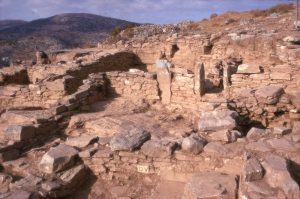
Industrial Quarter
The project aims at a better understanding of the object-assemblages found in various domestic contexts of Thorikos. The Industrial Quarter is the main focus of this project. From earlier excavations and research, a general chronology and line of development have been established for this sector of the ancient town. The earliest architectural remains of the residential area date back to the 5th century, but ceramic evidence shows that the area had been occupied already in the 6th century. After a brief period of depopulation, or drop in the activities, the 4th century is marked by important transformations and reuse of various earlier houses for the installation of metallurgical workshops. The present project will investigate this general chronological frame in Insula 2 and the Tower Compound (House 3) and, in a second stage, confront the results with the data and results of a domestic context outside the Industrial Quarter proper, House 2, next to the Theatre, studied by Arnout Van Belle (Ghent University) and House 5, studied by Johannes Bergemann (Georg-August-Universität Göttingen). Studying the material within their assemblages and within their architectural frame will offer a better understanding of the functional transformation of the different units throughout the history of the settlement.
Delphine TONGLET
Spitaels, P. 1978, ‘Insula 3. Tower Compound 1’, in Thorikos VII, 39-110; Mussche, H. 1998, Thorikos. A mining town in ancient Attika (Fouilles de Thorikos/Opgravingen van Thorikos II), Ghent, 55; Kalaitzoglou, G. 2004, ‘Zur Baugeschichte des Turmkomplexes 1 der Insula 3 von Thorikos’, BOREAS 27, 67-94.
